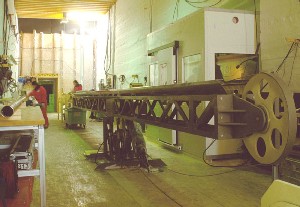|
|
 |
|
|
|
 |
| |
|
|
 |
How are
people changing
the climate?
Basics |
1. Man-made climate change?
How do we know that people have affected the climate?
Scientists have seriously discussed the risk of human-induced climate change for at least three decades. Many governments and non-scientists started worrying in the late 1980s, when the problem made headlines in newspapers and on TV around the world. Since that time, scientists have discovered much more about the causes of climate change. |
|
|
|
|
 |
|
In 2001, the Intergovernmental Panel on Climate Change (IPCC) (you can read more about IPCC in unit no 2), which is made up of experts from around the world, concluded that it was virtually certain that man-made emissions of greenhouse gases had contributed significantly to the observed climate change over the last 30 to 50 years.
|
What is this conclusion based on? It is founded on better and more comprehensive observations of climate change. Since the 1800s, weather stations around the world have registered the temperature using thermometers. Since the mid 1900s, the CO2 content of the atmosphere has also been registered. And since the 1970s, satellites have measured the sun’s rays entering the atmosphere and the heat radiated back to outer space. By analyzing samples of ice taken from deep down in glaciers and samples of mud taken from lake bottoms, scientists can also map climate change far back in time.
These observations lead the scientists to attempt to find the causes of the changes in the Earth’s climate, and to predict how the climate may change in the future. Because the climate system is so large and complex, scientists have relied heavily on so-called climate models.
Climate models
|
 |
 |
 |
|
1. DRILLING FOR INFORMATION: Outside it is colder than -40°C, so it is best to build a shelter when drilling for ice in Antarctica. Scientists from several European countries have been drilling for years to reach more than 3 kilometers down through the ice. They have reached more than 900,000 years old ice. Photo: Marzena Kaczmarska/NPI (click to enlarge, 31 kB)
|
|
 |
 |
|
2. MODELS: A model is a simplified representation of reality. What all models have in common is that they simplify what they are supposed to represent or describe. Here you see a model of a molecule (DNA, which contains our genes), and a model of a building (the Knossos temple on Crete). Image: Corel Gallery
|
|
 |
A climate model is usually a computer program where scientists enter in what they know about how sunlight, greenhouse gases, the atmosphere, and the oceans interact and shape the climate throughout the world. The model can be used to study what might be the causes of an observed change in the climate. When scientists include both the impact of natural factors and man-made emissions of greenhouse gases and particles over the last hundred years, the model calculates a change in climate that closely resembles the change that has been actually observed. |
|
Climate models can also represent and estimate how the climate will change in the future. For example, they can estimate future changes in temperature on the basis of assumed concentrations of greenhouse gases, particle concentrations, solar intensity, and other conditions that affect the climate. The most complicated climate models require enormous computers, and often take months to complete a single simulation.
The model estimates always carry some degree of uncertainty. Not only do models simplify reality, but there are also some mechanisms in the climate system that we currently do not understand well enough. For example, scientists are still uncertain about, for example, the roles that particles, cloud cover, and oceans play in global warming. This is one reason why the climate models are unable to predict the future climate with full certainty. Another important reason is that we can only guess what future emissions of greenhouse gases and particles will be.
Below are some links that describe some of the reasons why model estimates are uncertain:
The more specific a forecast we make, the more uncertain it is. For example, it is much more difficult to make certain predictions about climate changes in a specific country than it is to predict general developments for the planet as a whole. Likewise, a model may not be able to predict the exact year changes will take place, but it can state with more certainty a time period when such changes are likely to take place. Although we have a hard time knowing just how serious human-induced climate changes will be, exactly where and when the changes will take place, or what the consequences will be, we can be virtually certain that people have changed the climate and will continue to do so in the years ahead.
Next page
Author: Camilla Schreiner - CICERO (Center for International Climate and Environmental Research - Oslo) - Norway. Scientific reviewers: Andreas Tjernshaugen - CICERO (Center for International Climate and Environmental Research - Oslo) - Norway - 2004-01-20 and Knut Alfsen - Statistics Norway - Norway - 2003-09-12. Educational reviewer: Nina Arnesen - Marienlyst school in Oslo - Norway - 2004-03-10. Last update: 2004-03-27.
|
|
 |
|









